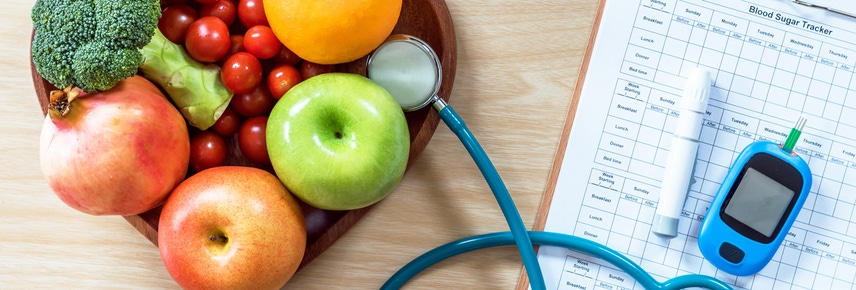Type 2 diabetes has become Australia’s fastest growing chronic disease and it’s becoming increasingly prevalent among adolescents and children. Nearly 1.2 million Australians have been diagnosed with type 2 diabetes and a further 500,000 are estimated to be living with the disease but don’t yet know it.
People with diabetes are at greater risk for heart disease, so reducing your risk for diabetes includes ways to reduce blood sugar levels as well as blood lipids such as cholesterol and triglycerides.
Our nutrition fact sheets, created by accredited dietitians, provide the latest nutrition and lifestyle information to help you understand which foods are the best to eat. Click here to see the diabetes type 2 nutrition fact sheet.
What can you do to reduce your risk of developing type 2 diabetes?
1. Focus on whole, plant foods
Evidence is accumulating that plant-based eating patterns can help both prevent and manage type 2 diabetes. Studies have found that eating more red meat, processed meat, haem iron (the iron found in meat) and animal protein are associated with an increased risk of type 2 diabetes and heart disease, while plant proteins may help decrease your risk.
Basing most of what you eat on a variety of wholefoods, including wholegrain breads and cereals, fruits and vegetables, legumes, nuts and seeds will help to lower your risk of diabetes. In a recent review, individuals who followed a vegetarian diet had a 27% lower risk of developing type 2 diabetes compared to non-vegetarians. This may be in part due to plant-based diets being generally high in fibre and phytochemicals which are important for gut health. Promoting the growth of certain good gut bugs (like Bifidobacterium) by including a range of fibres in the diet has been associated with a decreased risk of type 2 diabetes.
In addition, plant-based diets are associated with significant improvements in quality of life, general health, weight management, as well as diabetes and cholesterol control for people living with type 2 diabetes.
Our tip? Try replacing some meat meals with plant proteins such as legumes as these are high in fibre and help to manage blood sugars and cholesterol. At the same time, it’s important to limit highly processed high fat and high sugar foods.
2. Choose low GI carbs
Low GI (Glycaemic Index) carbs help manage blood glucose and keep you feeling fuller for longer, which means you snack less, have fewer cravings throughout the day and can concentrate better. In comparison, high GI carbs are broken down quickly, causing sudden spikes in blood sugar levels. Over time, blood sugar levels that rise and fall rapidly can disrupt the natural blood glucose balance in the body. This can make it difficult for your body to respond properly to changing glucose levels, increasing the risk of health conditions like type 2 diabetes.
Low GI carbohydrates tend to be wholegrains and include brown long-grain rice, wholegrain traditional oats, 'al dente' wholemeal pastas, authentic sourdough breads, dense wholegrain/multigrain breads (such as soy and linseed), quinoa, buckwheat and barley. There are also a number of low GI starchy vegetables such as parsnips, sweet potato, corn, legumes, taro and green banana. For more information on low GI foods visit the GI Foundation website.
If you are living with type 2 diabetes, it is also important to eat regular meals and have similar amounts of carbohydrates at each meal to help manage your blood sugar levels.
3. Choose healthy fats every day
Nourishing plant fats from wholefoods, such as extra virgin olive oil, unsalted nuts and seeds, nut and seed butters and avocado will help slow the release of glucose into your bloodstream, meaning better blood-sugar control. They will also help to reduce inflammation in your body, which has been linked to a range of chronic diseases, including diabetes.
What about low carb, high fat (LCHF) diets? Learn about the pros and cons here
4. Lose weight
Carrying extra weight, especially around your middle, is a key risk factor for type 2 diabetes. Aim to achieve a healthy weight - even losing a few kilos can significantly reduce your risk. Studies continue to show a diet rich in whole, plant foods is the best way to lose weight. Portion size is an important consideration too. In fact, almost all weight loss diets, regardless of their seemingly conflicting approaches, have a common theme: "Food, not too much, mostly plants".
Need more help to lose weight? Here are our dietitian's top weight loss tips.
Plus find out why it gets harder to lose weight as you get older.
5. Get checked
It's important to get your blood glucose levels checked by your doctor at least every year or two, especially if you’re overweight or have a family history of diabetes. If you do have diabetes in your family, remember that while it does increase your risk, it doesn’t mean you'll develop the disease. Take control to reduce your risk.
For more information visit Diabetes Australia.
There is no 'one size fits all' approach for managing diabetes, so we recommend that if you are living with diabetes that you discuss your diet with an Accredited Practising Dietitian (APD) and your diabetes care team who will be able to provide individualised advice specific to your needs. Dietitians Australia can help you find a dietitian.
About diabetes
Type 1 diabetes
This is an auto-immune condition when the body’s immune system destroys insulin-producing cells in the pancreas. This means that people with type 1 diabetes can’t make their own insulin and need to use insulin injections or an insulin pump several times each day.
How is it caused? It is not yet known what causes type 1 diabetes and no cure has yet been found.
Type 2 diabetes
This is a lifestyle-related condition and is a chronic disease. It’s most commonly found in adults over 45, although we are now seeing children as young as five being diagnosed with type 2 diabetes due to the increase in childhood obesity.
How is it caused? Type 2 diabetes is mainly caused by extra body weight and poor eating and lifestyle habits. However it also has strong genetic and family related risk factors.
Gestational diabetes
This is a type of diabetes that occurs during pregnancy. It normally goes away after the baby is born, although it does increase the risk of the mother developing type 2 diabetes in the future.
Gestational diabetes can generally be managed by following a healthy lifestyle but for some women, insulin injections may be required.



